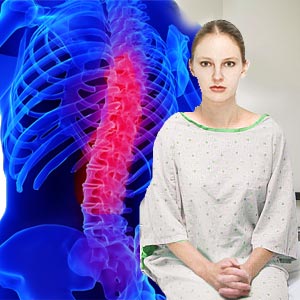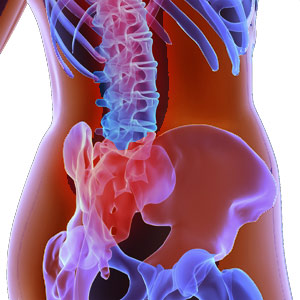Osteopenia

Osteopenia refers to a condition wherein the bone mineral density (BMD) becomes lower than the normal level. The level might not drop as much as in the case of osteoporosis but it does drop considerably. In simple terms osteopenia means low bone density caused by bone loss. Osteopenia is coined from the Greek words, osteon meaning bone and penia meaning poverty, so osteopenia means bone poverty.
The amount of minerals in the bone indicates how dense and strong they are. Bone mineral density is a measure used to determine the density of minerals in the bone. If the BMD is low when compared to normal peak BMD, the condition is termed as osteopenia. This condition is a forerunner to osteoporosis, a condition relating to brittle bones. A study indicates that 33.6 million Americans suffer from osteopenia.
As people age, they begin to lose their bone density, their bones tend to get thinner. This is so because during middle age, the already existing bone cells are reabsorbed quickly by the body. But the formation of new bone does not happen at a rate which can counterbalance normal bone loss. A normal human attains peak BMD levels at the age of 30, from then on the bone mass begins to drop. It is also understood that people having thick bones at the age of 30 take longer to lose the density of bones.
It is very important to understand that osteopenia is completely different from osteoporosis. Osteoporosis is a disease condition while osteopenia is not. Osteopenia is considered as an indicator for risk of fractures.
Osteopenia causes
- Exposure to radiation can cause osteopenia.
- Chemotherapy can cause this condition.
- Medications such as steroids can cause osteopenia.
- Metabolism problems can also cause this condition as the body is unable to absorb sufficient minerals and vitamins required for the bones.
- A few people with osteopenia might not experience bone loss but might have lower bone density.
- Other disease conditions can also lead to osteopenia.
- Women suffer more from this condition when compared to men as women experience loss of bone mass during menopause.
- Family history of osteopenia can also cause this condition.
- Excessive smoking, alcohol, cola drinks can also cause this condition.
Osteopenia symptoms
- Osteopenia exhibits no symptoms.
- No pain or changes are noticed as the bones become thinner.
- The risk of breaking a bone is higher as the density of the bones becomes lesser.
Osteopenia diagnosis
If your doctor relates your condition to osteopenia, you will be ordered the following tests.
- Bone mineral density test also popular as the BMD test - DEXA x-ray technique is used as it can detect as little as 2% bone loss per year.
According to WHO, a T score higher than -2.5 but lower than -1.0 indicates osteopenia. A T score above -1 is normal.
(T score is the bone density compared with what is normally expected in a healthy young adult of the same sex.)
Osteopenia treatment
- Treatment is provided to prevent the condition from developing into osteoporosis.
- Lifestyle changes are recommended.
- Diet modifications are made, sources of calcium such as milk, green vegetables, dairy products, etc need to be included.
- Calcium supplements enriched with vitamin D are prescribed.
- Magnesium is also essential. Whole grains, legumes, green vegetables, etc are a rich source of magnesium.
- Regular exercise is recommended as exercising helps the body to maintain strong bones. Walking, aerobic exercises, dancing, hiking, etc are exercises that help strengthening the bones.
- Medications to treat bone thinning are available but used only if the patient has crossed the stages of osteopenia and is stepping into osteoporosis.
Osteopenia prevention
- Try and improve the density of your bones by exercising regularly and eating a healthy and balanced diet rich in calcium and vitamin D.
- Spend a little time under the sun as sun is a rich source of vitamin D.
- Avoid smoking, alcohol and consuming cola drinks.
- Get into doing weight-bearing exercises regularly.
Osteopenia exercises
Osteopenia exercise treatment can prevent fractures. It can reverse bone loss too.
Walking can help strengthening the bones, walk for at least fifteen minutes a day. Walking is supposed to be one of the best weight-bearing exercises. The entire upper body is supported by the lumbar spine - tucking in the abdomen while walking strengthens and tones the core muscles of the trunk.
Begin with exercises that will strengthen your legs and hips. Sit on a straight chair. Try rising without using the support of your hands.
Hip exercises (hip kick)
- Stand with one hand against a wall for support.
- Lift your leg to the side (straight) as far as you can.
- Now bring your leg back down. Do it on the other side too.
- Now extend your leg out to the back.
- Keep you leg straight, bring your leg back to position and extend it out in front of you.
- Repeat for 8 times and do the same with the other leg.
Spine exercises
- Lie flat on your stomach.
- Keep your feet close together.
- Place your arms along the sides of your body with your palm facing up.
- Pressing down with your feet, slowly raise your upper body. While lifting the hipbones, knees and feet should be pressed against the floor.
- Lower it slowly.
- Do it gently and do not strain yourself too much.
- Repeat the movement for a few times.
Wrist exercises
- Sit in a chair and support your forearm on your thigh.
- Extend your wrist a little past your knees and allow it to hang.
- Hold a food can (1lb/2lb) in your hand.
- Bring your wrist up so that your hand forms a straight line with your forearm.
- Bring back wrist to position and repeat the movement for about 10 times.
Osteopenia score
The DXA scan measures bone mineral density as a basic score. This score is further converted to a T score. The T score represents the standard deviation, higher or lower than the mean value for a healthy 30 year old adult of the same sex and civilization.
The WHO recognizes 3 T-scores:
Normal: T score greater than or equal to -1.
Osteopenia: T score between -1 and -2.5
Osteoporosis: T score less than or equal to -2.5
As the standard deviation decreases, risk for fracture doubles. T scores can be improved with exercises, calcium supplements, vitamin D supplements, etc. As the bone density of the patient improves, and so does the T score.
Top of the Page: Osteopenia
Tags:#osteopenia symptoms #osteopenia treatment #osteopenia exercises #osteopenia t score
 Slipped Disc
Slipped Disc Knee Replacement for Women
Rheumatoid Arthritis
Osteoarthritis
Drop Wrist Deformity
Ankylosing Spondylitis
Spinal Decompression
Scoliosis Treatment
Cause of Osteoporosis
Osteopenia
Bone Density Test
Disc Herniation
Tennis Elbow Symptoms
Restless Leg Syndrome Symptoms
Other health topics in TargetWoman Women Health section:
General Women Health

Women Health Tips - Women Health - key to understanding your health ...
Cardiac Care
Women's Heart Attack Symptoms - Identify heart problems...
Skin Diseases
Stress Hives - Red itchy spots ...
Women Disorders
Endocrine Disorder - Play a key role in overall wellbeing ...
Women's Reproductive Health
Testosterone Cream for Women - Hormone replacement option ...
Pregnancy
Pregnancy - Regulate your lifestyle to accommodate the needs of pregnancy ...
Head and Face
Sinus Infection - Nearly 1 of every 7 Americans suffer from ....
Women and Bone Care

Slipped Disc - Prevent injury, reduce pain ...
Menstrual Disorders
Enlarged Uterus - Uterus larger than normal size ...
Female Urinary Problems
Bladder Problems in Women - Treatable and curable ...
Gastrointestinal Disorders
Causes of Stomach Ulcers - Burning feeling in the gut ...
Respiratory Disorders
Lung function Test - How well do you breathe ...
Sleep Management

Insomnia and Weight Gain - Sleep it off ...
Psychological Disorders in Women
Mood swings and women - Not going crazy ...
Supplements for Women
Women's Vitamins - Wellness needs...
Natural Remedies

Natural Diuretic - Flush out toxins ...
Alternative Therapy
Acupuncture Point - Feel the pins and needles ...
Women Health Directory
Top of the Page: Osteopenia
Popularity Index: 100,968

